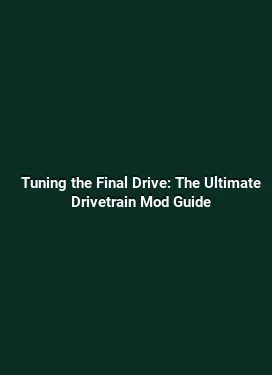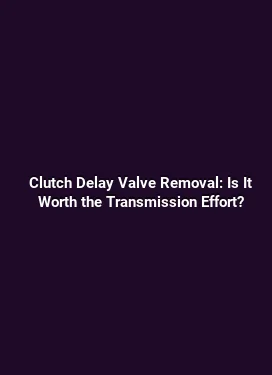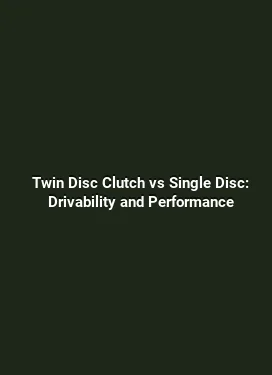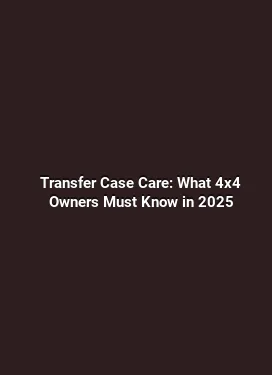Understanding Torque Converters: A Drivetrain Performance Guide
Torque converters are a central element of automatic transmissions, acting as the hydraulic link between the engine and the drivetrain. Far from being a simple coupling, a torque converter dynamically manages torque, speed, and fluid dynamics to optimize acceleration, fuel efficiency, and smoothness across a wide operating range. This guide dives into the inner workings, practical implications for different drivetrain configurations, and actionable maintenance and upgrade tips designed to help enthusiasts, technicians, and manufacturers maximize performance and reliability.
What is a Torque Converter and How It Works

A torque converter is a fluid-coupled device that transfers rotational power from an engine to a transaxle or transmission. It consists of three main rotating components: the impeller (pump), the turbine, and the stator. These elements operate inside a sealed housing filled with transmission fluid. When the engine turns the impeller, fluid is propelled toward the turbine, creating torque. The stationary or slowly turning stator redirects the fluid, increasing hydraulic efficiency and multiplying torque at low to mid RPMs. As engine speed rises, the torque converter allows slip between the input and output, enabling smooth acceleration without stalling the engine.
Essentially, the torque converter acts as a continuously variable multiplier of torque, with the degree of multiplication depending on engine speed, fluid temperature, and hydraulic pressure inside the unit. In many modern designs, a lock-up clutch within the torque converter engages at higher speeds to eliminate slippage and improve efficiency by creating a direct mechanical connection between the engine and the drivetrain.
Key Components: Impeller, Turbine, and Stator

The impeller is connected to the engine and drives the transmission fluid outward through centrifugal force. The turbine is attached to the transmission input shaft, receiving the energized fluid and transmitting torque onward. The stator sits between the impeller and turbine and redirects the fluid back to the impeller with a change in direction that amplifies torque. The balance among these components determines stall characteristics, torque multiplication, and overall responsiveness in different driving scenarios.
In a typical stall scenario, the engine is producing high torque while the drivetrain remains stationary or moving very slowly, allowing the torque converter to multiply torque for a controlled launch. As vehicle speed increases, fluid dynamics shift, reducing slip and allowing the system to operate closer to a mechanical direct drive. This behavior is central to how automatic transmissions manage power delivery without abrupt surges or fuel-inefficient full-throttle engagements.
Hydraulic Fluid and Cooling
Transmission fluid isn’t a simple lubricant in this system; it’s a hydraulic medium that transmits torque through pressure differentials. The fluid also provides cooling, lubrication, and contaminant removal. The viscosity of the fluid and its thermal stability influence slip, pressure generation, and overall efficiency. Poor fluid condition—whether due to contamination, oxidation, or incorrect grade—can lead to excessive slipping, heat buildup, and reduced torque multiplication. Regular fluid checks, based on manufacturer intervals and operating conditions, help sustain performance and protect the torque converter from premature wear.
Performance Implications for Different Drivetrain Setups
Torque converters impact a wide range of drivetrain configurations, from front-wheel-drive to all-wheel-drive systems, and across various performance targets. Understanding how the converter interacts with gearing, torque curves, and vehicle weight helps tailor upgrades and maintenance plans for specific applications. The following sections explore common scenarios and the practical implications of torque converter behavior.
Urban Commuting and Fuel Efficiency
In stop-and-go driving, a well-tuned torque converter with efficient lock-up can minimize slippage and reduce parasitic losses. A smoothly engaging lock-up clutch reduces circulating fluid drag in high gear and improves highway fuel economy. For urban driving, selecting a converter with optimized stall characteristics can improve initial response without sacrificing reliability or transmission longevity. Fluid temperature management becomes particularly important in this context, as higher temperatures can degrade efficiency and increase wear over time.
Drivers may notice improved drivability when the converter locks at lower highway speeds, creating a more direct engine-to-road connection. This not only enhances throttle response but also reduces heat generated by prolonged slip at typical cruising speeds. In modern systems, adaptive control strategies modulate lock-up clutch engagement based on driving conditions, which helps preserve fuel economy while maintaining smooth acceleration.
Performance and Tuning for Enthusiast Applications
Performance-oriented builds often require deliberate changes to torque converter characteristics, such as increased torque capacity, altered stall speed, and refined lock-up behavior. A higher stall torque converter can improve launch at the track or in off-road environments where the engine can reach higher RPMs before loading the drivetrain. However, a too-high stall can reduce low-end drivability in daily driving. Tire grip, gearing, and engine power curves must be considered in concert with converter selection.
Advanced setups may pair a performance torque converter with a stronger transmission cooler, enhanced lubricant filtration, and precise hydraulic pressure tuning. The goal is to maintain consistent hydraulic pressure across temperature ranges, ensuring reliable torque multiplication and clean engagement even under repeated high-load cycles. For enthusiasts, a well-chosen converter supports rapid throttle response, reduced drivetrain stress, and a more linear power delivery profile, especially when paired with a compatible torque curve and gearing strategy.
All-Wheel Drive and Transaxle Interactions
In AWD layouts, torque converter behavior influences how power is redistributed across axles and how the transmission negotiates traction under varying grip conditions. The interaction with transfer cases or center differentials can amplify or dampen the perceived torque delivery, especially during cornering or when wheel slip occurs. In such systems, fluid dynamics and hydraulic pressure must be managed to sustain consistent torque transfer without overheating or excessive slip in individual components.
Manufacturers often integrate adaptive control algorithms that adjust lock-up timing and pressure profiles to preserve drivability and stability in diverse conditions. For performance-oriented AWD builds, selecting a torque converter with robust torque capacity and controllable slip behavior is essential to maintaining balanced power distribution and preventing drivetrain fatigue.
Maintenance, Diagnostics, and Practical Upgrades
Regular maintenance and informed diagnostics are essential to preserving torque converter health and ensuring consistent drivetrain performance. The following sections provide practical guidance, including preventive checks, troubleshooting signs, and upgrade options that can yield tangible improvements in everyday driving and high-demand scenarios.
Maintenance Essentials
Fluid condition is a primary indicator of torque converter health. Transmission fluid should be inspected for color, aroma, and contamination, with parameters aligned to manufacturer specifications. Oily or burnt smells can indicate overheating or aging within the torque converter or the surrounding transmission. Regularly scheduled drain-and-fill intervals help remove degraded fluid and particulates, supporting smoother engagement and better heat dissipation.
Cooler performance is another critical factor. A well-functioning cooler keeps transmission fluid temperatures within an optimal range, reducing the risk of thermal breakdown and fluid thinning. When the cooling system shows signs of inefficiency, such as overheating during hot weather or heavy loads, upgrades like an auxiliary cooler or improved routing can make a noticeable difference in longevity and performance consistency.
Diagnostics: Reading the Clues
Symptoms of torque converter issues often present as slipping, shuddering during takeoff, or harsh shifting. A slipping condition can indicate low fluid level, dirty fluid, or a failing stator or clutch assembly inside the converter. A shudder at launch or under light acceleration may point to fluid contamination, worn bearings, or a misbehaving lock-up clutch. Diagnosing these conditions requires a combination of fluid analysis, scan tooling for transmission codes, and, when necessary, bench testing of the unit or pressure readings across the hydraulic circuit.
Noise and heat signatures should also be considered. Unusual whining, grinding, or metallic tones during transmission operation can reveal wear in the turbine, impeller, or bearings rather than instant fluid fault. Excessive heat buildup is a warning sign of persistent slip, poor cooling, or a maladjusted hydraulic system. Timely attention to these cues can prevent cascading failures that affect the entire drivetrain.
Upgrades for Better Efficiency and Performance
Upgrading the torque converter can deliver meaningful gains in throttle response and launch characteristics, but it must be matched to the rest of the drivetrain. A converter with higher torque capacity and an optimized stall range can improve acceleration, particularly when paired with a performance-tuned transmission control strategy. However, compatibility with the engine’s torque curve, transmission gear ratios, and the vehicle’s aerodynamics is essential to prevent reduced efficiency at cruising speeds or unintended driveline vibrations.
Beyond the converter itself, consider complementary upgrades: a high-efficiency transmission cooler, an enhanced transmission filter, and fluid with improved thermal stability. Some enthusiasts also explore adjustable lock-up clutch systems that allow more aggressive slip control during towing or heavy-load conditions, while preserving fuel economy in normal driving. When contemplating upgrades, a holistic assessment of power, weight, gearing, and intended use will guide the best combination of components for reliable, repeatable performance gains.
Common Misconceptions and Real-World Insights
There are several myths surrounding torque converters that can mislead vehicle owners. A common misconception is that all torque converters are essentially the same across models. In reality, torque converters vary widely in stall speed, torque capacity, lock-up behavior, and hydraulic pressure characteristics. Another misconception is that a larger converter always delivers better response; size must be matched to engine torque, transmission type, and vehicle weight to achieve the desired balance of responsiveness and efficiency.
In practice, the most tangible improvements come from aligning the converter’s characteristics with the engine’s torque output, the transmission’s hydraulic capabilities, and the vehicle’s driving goals. For example, a sporty daily driver benefits from a lock-up regime that minimizes slip at highway speeds, while a drag-focused build might prioritize a converter with a higher stall to maximize launch power. The key is to tailor decisions to real-world usage patterns rather than relying on generic specifications alone.
Selecting the Right Torque Converter for Your Drivetrain
Choosing a torque converter involves evaluating several variables: engine torque curve, transmission type, vehicle weight, gearing, and typical driving conditions. Start with a clear objective—improved launch, better highway efficiency, or enhanced off-idle response—and work backward to identify a converter that aligns with those goals. Engage with reputable manufacturers and ensure compatibility with your transmission model and control system. Whenever possible, rely on dyno testing, track results, and long-term reliability data to validate the chosen setup.
Finally, it’s important to recognize that torque converter performance is inseparable from overall drivetrain tuning. Braking torque, clutch engagement timing, RPM target curves, and cooling capacity all contribute to the final feel and efficiency of the system. A cohesive approach that combines converter selection with proper transmission calibration and cooling optimization yields the most consistent, repeatable results for a wide range of driving scenarios.






